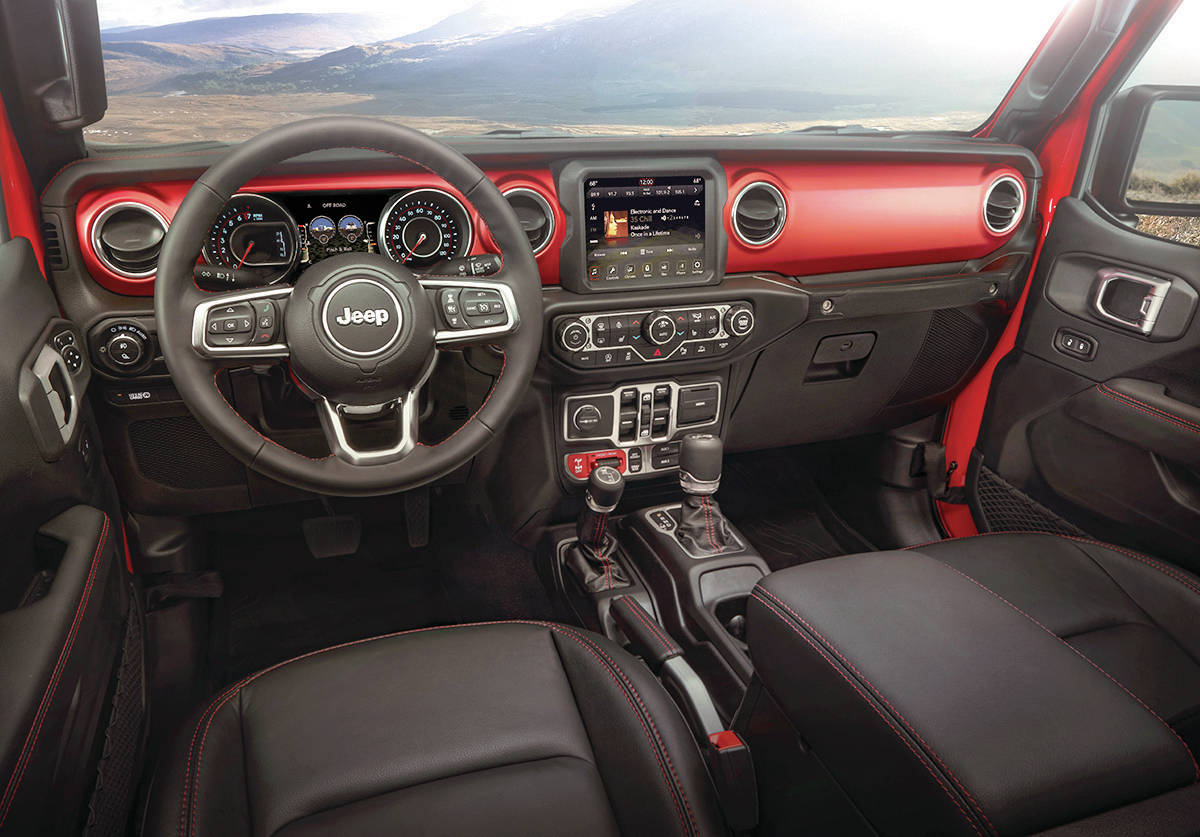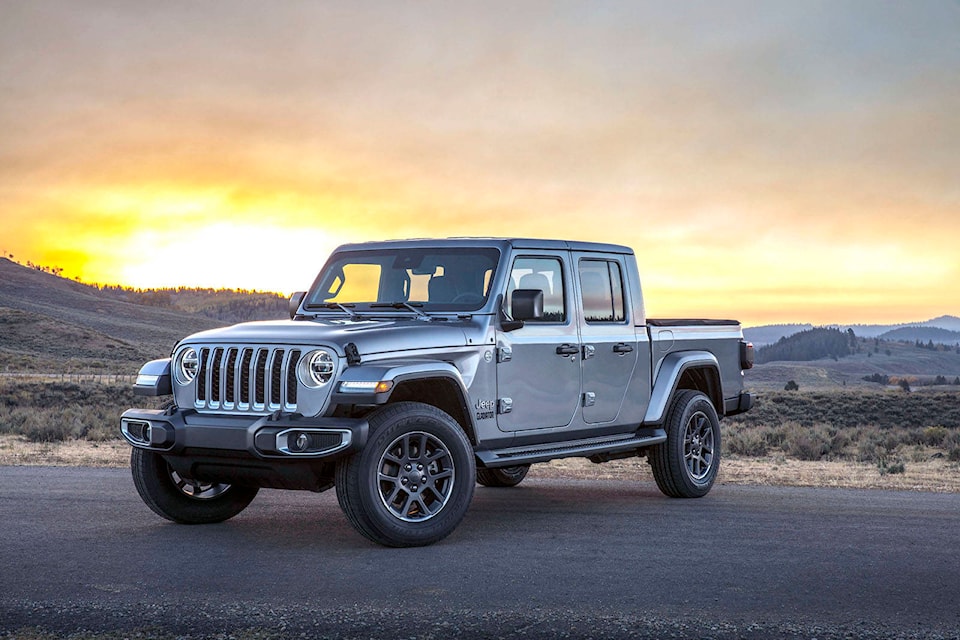The Jeep division of Fiat Chrysler Automobiles is no stranger to pickup production, having built various generations of them dating back to the original 1947 Willys Overland. So, with growing interest in off-road vehicles of all kinds, bringing a Jeep truck to market seems to make good sense.
Viewed head-on, the 2020 Jeep Gladiator looks like any other Jeep Wrangler, with a traditional slotted vertical grille, round headlights and a stout bumper. Behind the second-row seat is a five-foot-long box capable of transporting up to 725 kilograms of ATV, dirt bikes, camping gear and/or just about anything else you can imagine. Trailering capacity with the proper tow package tops out at 3,475kg.
To make the Gladiator, Jeep built a new — and stronger — frame, longer than the Wrangler Unlimited’s by about 80 centimetres. This was necessary to have a decent-sized box and the capability to put heavy things in it. As such, the Gladiator has a best-in-class tow rating.
The distance between the front and rear wheels is increased by about 50cm. The result is a smooth visual transition from passenger compartment to pickup bed. The Gladiator doesn’t really look like a Wrangler with a truck box slapped on the back.
As with other Wranglers, the Gladiator’s removable doors, hood, fenders, tailgate and fold-down windshield frame are made of aluminum. The Gladiator also matches other Wranglers with an ability to ford water up to 75cm deep, although with a longer wheelbase, there’s a slightly greater chance of being high-centred going over obstructions (like a teeter-totter).
The steel hardtop can be unbolted and replaced with an optional folding soft-top, or with a hardtop with dual removable roof panels that lets the sun shine over the front seats. A handy sliding rear-window is standard with either version.
The interior is pretty much a walkover from the other Wranglers, including a colour-keyed dashboard with myriad knobs and switches, along with a standard touch-screen for the infotainment system. The split-folding rear seat has storage compartments beneath the cushion as well as behind the seat back.
The standard 3.6-litre V-6 — 285 horsepower and 260 pound-feet of torque — will be familiar to Wrangler fans and moves the Gladiator along with surprising authority.
A recently added option is a 3.0-litre V-6 turbo-diesel that puts out 260 hp and 442 pound-feet. Note that the Gladiator can’t be ordered with the turbocharged 2.0-litre four-cylinder gasoline engine available in two- and four-door Wranglers.
A six-speed manual transmission or optional eight-speed automatic can be harnessed to the V-6, while the auto box is standard with the turbo-diesel.
Fuel consumption for the 3.6 and the automatic transmission is rated at 13.7 l/100 km in the city, 10.7 on the highway and 12.3 combined.
Command-Trac four-wheel-drive, which comes with all but the Rubicon trim, has a two-speed transfer case with low-range gearing.
The Rock-Trac system in the Rubicon has locking front and rear differentials plus steeper low-range gearing for crawling up and down sharp inclines.
Pricing for the base Sport S — one of three trims — starts at $45,900, including destination charges. It comes reasonably well turned out, but you’ll need to pony up a few more dollars for the Overland or Rubicon trims to get the seven-inch display, ambient interior lighting, side steps, satellite radio and other niceties.
Along with the Rock-Trac 4x4 system, the off-road thrashing Rubicon adds heavy-duty front and rear axles, specific Fox-brand shocks, high clearance fender flares, protective skid plates, dual front and rear tow hooks and 33-inch Falken off-road rubber.
As well as the available three-panel removable hard top, the options list includes leather-trimmed seats, nine-speaker Alpine audio system and all available active-safety technology, such as autonomous emergency braking and blind-spot warning.
With increasing competition in the category of off-road-capable-vehicles, the Gladiator — along with the two- and four-door Wrangler models — gives Jeep buyers a range of choices, all with a decades-old pedigree.

WHAT YOU SHOULD KNOW: 2020 JEEP GLADIATOR
Type: Four-door, four-wheel-drive midsize pickup
Engines (h.p.): 3.6-litre DOHC V-6 (285); 3.0-litre DOHC V-6, turbo-diesel (260)
Transmissions: Six-speed manual; eight-speed automatic (std. with turbo-diesel)
Market position:The Wrangler-based Gladiator stands to capitalize on the growing demand for traditional two-and four-door Jeep models. Premium priced based model, so consider it a niche Jeep model rather than a straight-up competitor in the midsize segment.
Points: Well-executed styling, front to back. • First-rate interior appointments include plenty of stowage spots. • V-6 is highly rated, but the turbo-diesel is great if more torque is needed. • Optional active-safety technologies should really be standard.
Dynamic safety: Blind-spot warning with cross-traffic backup alert (opt.); active collision warning (opt.); emergency braking (opt.)
L/100 km (city/hwy) 13.7/10.7 (3.6, AT); Base price (incl. destination) $45,900
BY COMPARISON:
Ford Ranger SuperCrew 4x4
- Base price: $37,900
- Ford’s compact pickup comes with a 270-h.p. turbocharged 2.3-liter I-4.
GMC Canyon Crew Cab 4x4
- Base price: $40,650
- Great style, roomy interior and an available 308-horsepower V-6.
Toyota Tacoma SR5 4x4
- Base price: $43,000
- Midsize companion to the Tundra comes with a full array of active-safety tech.
– written by Malcolm Gunn, Managing Partner at Wheelbase Media



